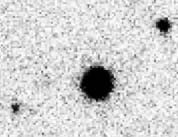|
A spirited debate among cosmologists is the intriguing mystery of supermassive black holes (SMBHs) forming soon after cosmic dawn, and how these relate to the formation of galaxies and quasars.
Cosmic dawn occurred about 200 million years after the Big Bang, when the first stars were born, illuminating the universe that had been dark since the emission of the CMB (Cosmic Microwave Background radiation) some 479,000 years after the Big Bang.
As an appetizer, the most luminous quasar (SMSS J2157) is 700 trillion times brighter than our Sun, powered by gas from its host galaxy falling into a SMBH with a mass of 34 billion Suns.

We see this beast (large body near center) “at redshift z=4.7”, which means this image shows us what it looked like when our universe was 17.5% [1/(1+4.7)] of its current size, which corresponds to 12.55 billion years ago, 1.25 billion years after the Big Bang.
Cosmologists scratch their heads wondering how something grew that big that quickly.
As with all cosmic bodies, we see each one at one brief instant — the farther away they are, the further back in time we see them. We never get to see how any particular cosmic body evolves over millions of years [see footnote].
Another monster is TON 618 (a very understated name), with an estimated mass of 66 billion Suns, which we see at z=2.2, as it was over 10 billion years ago.
Since we can’t see any individual SMBH evolve, we model these processes mathematically. Muhammad Latif of United Arab Emirates University & Sadegh Khochfar of University of Edinburgh recently published a simulation showing how they think SMBHs and galaxies might grow together, creating quasars.
Black holes (BHs) can form in at least two different ways.
We think most BHs are the final remains of massive stars that consumed all their fuel and can no longer sustain nuclear fusion. These stars die in catastrophic supernova explosions — their outer layers are blasted off into the cosmos, while their cores, crushed by their own immense self-gravity, implode into tiny balls trillions of times smaller than a normal atom. BHs can form this way only after cosmic dawn, when the first stars were born.
Alternatively, BHs may have formed much earlier in a different way. In the early universe, the density of matter was much greater, and gas clouds of sufficient mass might have collapsed directly into black holes without any stellar intermediary.
In their simulation, these authors assume clouds of primordial gas, with total masses exceeding 1 billion Suns. As these clouds evolve, they fragment, with some fragments collapsing directly into BHs with masses of 100,000 Suns. From there, the authors say, these BHs could grow big enough fast enough to become the SMBHs we observe.
Footnote: How we see the cosmic past. When astronomers say a celestial body is 1 billion light-years away, what they really mean is that the light we see today was emitted by that body 1 billion years ago. During these 1 billion years, that body has moved even farther away. The light we see today shows us what that body looked like 1 billion years ago, when the light was emitted. The light we see tomorrow shows us what that body looked like 1 day later. Unless we could wait 1 billion years, we will never know what that body looks like today.
Additionally, we will never know what that body looked like 1 billion and 1000 years ago, because that light passed Earth 1000 years ago before anyone could take its picture, and will never pass Earth again.
Hence we can only see each cosmic body at one instant in cosmic time, and how long ago that instant was is determined by how far away that body was.
Best Wishes,
Robert

July 2021
Note: Previous newsletters can be found on my website.
|